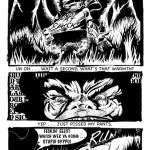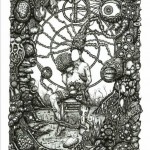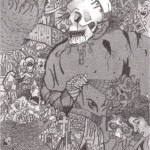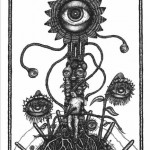Archive for May, 2010
Interview with Mike “Frick” Weber
The March issue of Niteblade included a short review of The Field on the Edge of the Woods. It’s my pleasure to give you something else related to it before Volume II is released. Mike “Frick” Weber took time out of his busy schedule to answer some questions about the project. The interview begins with a question that was on my mind when I saw who was given credit for Volume I.
How did you get the nickname “Frick”?
Swim team in high school . . . my real name is Mike, and there’s a lot of other Mike’s out there . . . so it kind of stuck, I think it makes it easier for other people to keep track of all the Mike’s they know.
I read in another interview you wrote the story, Gary Morgan does the penciling and Loran Skinkis handles the inking. The Field on the Edge of the Woods is a collaboration that competes with home life and other jobs for time. How often do the three of you meet to discuss and review the project?
Does NOT ENOUGH qualify as an answer? . . . I think we’re all on Verizon wireless so we talk and text a lot . . . when we do meet, it’s usually about once a month, and it serves as a great deadline of sorts. While I don’t think most artists like deadlines, they are very helpful to keep us all on track.
Why was the decision made to release The Field on the Edge of the Woods into four volumes? I’ve read the first volume. It hooked me in but left me with a lot of questions while I wait for the second volume.
Well, we’re new at this . . . so I don’t think we’d be able to keep up with the timeline of doing a once a month issue, so we figured we’d do our best to give the reader twice as much (48 pages) and sell it for less than that standard Marvel or DC issue ($2.99). . . the downside is where we are now, having to pretty much beg the patience and forgiveness of the readers while we put together the next 48 page book. We’re a work in progress.
How long did it take from the first meeting to produce the first volume?
1 year.
I’ve heard the stories from Jeff Smith and Terry Moore on what it’s like to independently produce a comic. For them it was doing nearly everything from start to finish while their wives helped with some of the distribution duties. How do the three of you divvy up the work?
It’s funny you mention Terry Moore, I met him at the Pittsburgh Con last year and talked with him and his wife for about 2 hours on producing independent books . . . he’s a very lucky man, not only is he talented, but he has a great wife to help out with all of the production/marketing, which is a full time job in and of itself. I’m the one usually doing the marketing and promotion, even though we all reach out via emails, facebook, shows, stopping by shops . . . it’s not unusual for me to spend 4 or 5 hours a night just sending out emails to various people in the industry . . . it takes away from everything else, but it’s the only way to get your stuff out there, and when you stop spending time and doing things like that . . . the interest you’ve created pretty much dries up. We just started a facebook page of the book (THE FIELD ON THE EDGE OF THE WOODS) so hopefully we can use it as a way to reach out, keep everyone updated, and let them all share along in the process by posting pencils, sketches, roughs, and previews.
How long has this particular story been in your head?
Wow, 19 years . . . it grew from a 1 Act Play I wrote in high school. And it just kind of bounced around and grew . . . I’m a big day dreamer, and I listen to sound track music a lot in my car, so it’s kind of like my own private movie theater in my head. I wrote it as a film script, and when I got together with Gary and Loran, I let them read few of the different stories I’ve written and then they picked the one they liked . . . they like THE FIELD ON THE EDGE OF THE WOODS, and I hope you guys do to. (wow, that’s so cheesy, did I just write that? . . . yep, I did.)
Why did you choose the comic book format to tell it?
I’m a filmmaker at heart . . . and now I am also a husband, father, and monetary provider . . . who loves to spend time with his family AND loves his job (video producer / director / editor) . . . and the last indy film I did (KEEPING THEM BLIND) really kicked my ass (am I allowed to swear?) . . . I did pretty much everything by myself, and it took so much time and effort, not sure I could do it again without sacrificing too much . . . and making comic books is just like making a film, except that you stop at the story board stage . . . for the most part.
Do you have any writing rituals or superstitions?
No. Unless “praying what I wrote doesn’t suck” counts? Hmmm, the first and second drafts never really see the light of day, and my wife is the first person to read the third draft. Then I pray again “that it doesn’t suck.” And if I’m really feeling down, and start feeling like a not talented, slug, who couldn’t write out a name tag . . . I shut everything down and go to bed. Things suck a lot less the next day.
Is it difficult to turn your words or stories over to other people for interpretation?
No, quite the opposite . . . Gary and Loran are so damn talented, it’s a huge thrill to see each panel (and I’m not just trying to suck up to them . . . well maybe?) . . . I so wish I could draw like them! It’s really cool when they add something that I didn’t even think of and it turns a triple into a home run. (sorry, I like to use a lot of analogies)
The web site, www.filmsandcomics.com, has a three-part film available titled Keeping Them Blind. What are your future film plans?
There are 5 parts and they’re on youtube. FILM PLANS . . . Hoping to see this book take off, and perhaps serve as director, producer, or even an editor. And with that, I have to really thank friendly people like you (Amber), Rhonda, and Niteblade . . . you guys don’t know us from a hole in the wall, and yet you wrote back to us, and were kind enough to look at our book and give us a review . . . and NOW THIS, an interview . . . WOW, we can’t thank you enough. So when this book does take off (and it will) and when we do make our make in the industry (and we will), please know that you guys had a big part in it. Thank you!
Thank you so much for allowing us to get to know you and The Field on the Edge of the Woods better. Below are thumbnails of some images from Volume I. (Click on them to see the larger individual panels.)
June Table of Contents
The table of contents for our June 2010 issue, Flea Market Zombies, has been finalised and I’m proud to share it with you. In no particular order:
Poetry
Lycanthropia by Simon A. Thalmann
Flea Market Zombies by Brian Rosenberger
Star Seed’s Arietta by Linda D. Addison
Mid-City Amusements by Alec B. Kowalczyk
Stories
Sympathetic Noose by Iris Macor
Woman Called Witch by Doug McIntire
The Little Girl and the Balloon by Ben Loory
Shinigami by Benel Germosen
Basement Shade by Bill Ratner
Survivalist by Kevin Brown
Stoke the Fires by Brad Chacos
Icarus Redux by Elissa Malcohn
Seances with the Living . . .
Seances with the Living . . .
Book Review by A. R. Braun
Seances with the Living . . . is a short story book by award-winning horror author Johnny S. Geddes. I’m impressed with his intelligence, as a lot of his stories go over my head. The bad news? He only hits it about 1/3rd of the time. I prefer to be entertained, not outsmarted. There are some winners here, so it’s worth checking out, if you can get past all the grammar and spelling mistakes. There’s also a lot of author voice intrusion. I don’t want a writer to say, “Now this is the part that will really get you.” Just get me and blow me away.
The opening descriptions are written beautifully, the author saying, “Just stories?” and then going on to setting up the landscape of not only the shorts contained within but also descriptions of his other books, which looked like very tempting purchases indeed. The introduction, “Infamous First Words,” by the author himself, compares reading the book to picking the author up as a hitchhiker, dangerous but not too threatening, knowing how to drive you to strange worlds that will keep you up later than you know you should stay up, seeing as you have to report to work in the morning–something all good writers do.
The stories I feel deserve honorable mention:
“And You Get Three Wishes,” is about a young man dealing with the kidnapping of his parents by a shopping catalogue distributor who offers a horror of horrors; “A Friendly Bet,” about Delta and Omega inside a computer ruining people’s lives; and “Old Flame,” about a Catholic father having to exorcise a demon in the future to disastrous results. The first story mentioned won him his first award and, as you read it, you’ll understand why. “Old Flame” leans on sci-fi/horror, a true classic.
“Forever Bound,” is about a sailor stranded at sea who has to sell his soul to an Egyptian goddess if he ever wants to see dry land again and the tragedy that befalls him as he takes part in the curse; “The Gate Glass,” brilliantly provides the atmosphere of a life of hopeless poverty (which is scary enough in itself) and the “hope” that comes from a magic mirror he finds; “And Janus Jumped,” features a guilt-ridden programmer forced by the government to insert a computer chip into babies to insure they don’t live a life of crime–but which causes nasty side effects. Of all the pieces, “The Gate Glass” scared me the most. The man has lost his woman and is living in a poverty-ridden shack with Clockwork Orange-like characters chasing him. “And Janus Jumped” again leans on sci-fi, and there’s nothing wrong with that.
“Torquemada Town,” includes a village that had taken part in the inquisition that faces its comeuppance; “One Enchanted School Day,” shows a girl who’s Daddy has been taken from her after having a nervous breakdown. She plans revenge on the whole world by releasing bombs by hacking into a school computer; “The Overnaught,” casts a rich, selfish game designer enjoying a virtual vacation on Mars, only to happen upon an Egyptian god and the curse that follows; and “The Cherry Room,” is about the murder of a person of a different race by a very guilty white man, and the victim’s revenge . . .
Of all the stories, I think “The Overnaught” is my favorite, for the moral and the resolution, the payback coming to a money-hoarding jerk. I don’t mind the protagonist being the antagonist, as long as he gets what’s coming to him in the end!
I can see why Mr. Geddes won so many awards, but he’s hit-and-miss. I could’ve done without the fifty page unoriginal vampire story, “Chronophobes.” Still, there are tales here worth reading, stories you’ll want to add to your library of horror.
A. R. Braun
The Night The Cricket-Man Came
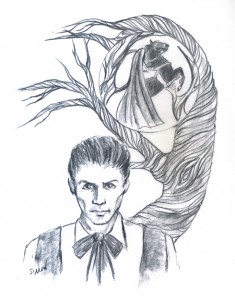
I don’t think it’s a secret that I enjoy good retellings of classic tales. Just look at the number of twisted or re-told fairy tales that grace the pages of Niteblade and you can see that. The Legend of Sleepy Hollow is one of those stories I’ve loved since I was a kid watching the Disney version on The Magical World of Disney on Sunday night. If I love a story as much as I do that one, then getting me to accept a retelling of it is a tricky thing.
Alejandro Omidsalar pulled it off.
The Night The Cricket-Man Came finds its roots in the classic story by Washington Irving, but grows into something quite wonderous all its own. I strongly recommend checking it out in the latest issue of Niteblade.
Intricate Terror: The Art of Scott Nellis
Come see incredibly intricate images of horror and the macabre. Spy surreal scenes of the the uncanny and the bizarre. Find transforming lycanthropes, terrifying monstrosities, and plague personified in the wonderfully detailed art of Scott Nellis.
Based in Brighton on the southern coast of England, Scott is a graduate of the University of Brighton with a BA (Hons) in Illustration. An artist that immerses himself in his work, Scott uses pen on paper to produce his elaborate creations. He often draws on a fairly large scale; his works typically range in size from A4 (8.3 x 11.7 in) to larger than A1 (23.4 x 33.1 in). As for artistic influences, Scott says that global and personal subjects, fantastical realms, the sub-conscious, and social conditioning all play a part in influencing his art.
- The Damned Forgotten by Scott Nellis
- Werewolf by Scott Nellis
- Prohibition by Scott Nellis
- The Plague by Scott Nellis
- Scrutiny by Scott Nellis
More of Scott’s work can be viewed at Scott Nellis Illustration.
***

